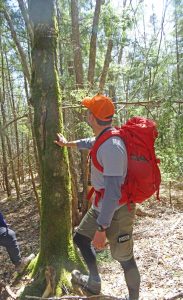From my records of species Sean Haughian pointed out and discussed, and some related links – david p
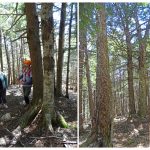 DIRT GANG FOREST WALK, pages DIRT GANG FOREST WALK, pages
– DirtGang Forest Walk Intro 21Apr2024 –> Sean H on lichens, mosses and liverworts STOP 1 An old (dead) beech by the path up the drumlin, hemlock-dominated forest. |
STOP 1, An old (dead) beech by the path up the drumlin, hemlock-dominated forest.
Noted by Sean H:
– Neckera complanata, Flat Feather Moss.
View Wikipedia Pic. Pics in Consortium of Bryophyte Herbaria (as Alleniella complanata) NatureServe Conservation Status: S5 (Secure in NS, lower rankings elsewhere).
– Leptogium cyanescens, Blue Jellyskin Lichen, “Grey spots on tree, leafy”, a cyanolichen. Many pics on Consortium of Lichen Herbaria. Inaturalist observation Sandy Lake area NatureServe Conservation Status: S5, (Secure in NS).
– Lobaria pulmonaria, Lungwort Lichen, higher up in the pic at right. Also a cyanolichen. Good description in Wikipedia. Many pics on Consortium of Lichen Herbaria. On NatureServe Conservation Status: S5 (Secure in NS).
 STOP 2: On Sugar maple in old mixed/hardwood-dominated forest.
STOP 2: On Sugar maple in old mixed/hardwood-dominated forest.
Noted by Sean H:
– Anaptychia palmulata, Shaggy Fringe Lichen. “Old Growth associate, not especially rare; bright green when wet.” Many pics on Consortium of Lichen Herbaria. My Pic of specimen on this tree pointed out by Sean NatureServe Conservation Status: S3 (Vulnerable in NS).
– Porella platyphylla, Scalewort
A liverwort. View description in Montana Field Guide. “Leafy liverworts that form flat mats when young, becoming thick tufts with age that protrude from trees and rocks. Strongly aromatic, but not acrid (Paton 1999). Shoots grow to 8 cm long, 1.8 to 2.7 mm wide, and are 2-3 times pinnate…” Pics on Consortium of Bryophyte Herbaria. On iNaturalist, Sandy Lake Area 1 and Sandy Lake Area 2 (On the Area 2 record, Sean H commented, “can’t really discriminate P. platyphylla from P. platyphylloidea based on morphology”. NatureServe Conservation Status: S5 (Secure in NS).
– Lobaria pulmonaria, Lungwort Lichen – see comments above
– Parmeliela tryptophylla, Black-bordered Shingle Lichen. “A cyanolichen, dark smear, not quite a crust lichen but close, occurs on mature to OG trees”. Pics on Consortium of Lichen Herbaria. Extract from Common Lichens of Northeastern North America (McMullin & Anderson 2014), p. 51: “SHAPE/SIZE: Tiny lobes 1 MM and less on a black fungal layer (hypothallus) that makes the entire lichen appear almost black from a distance. NOTES: ..often appears as a black patch on trees in humid forests. The tiny lobes are only visible close up.” NatureServe Conservation Status S5 (Secure in NS – low rankings elsewhere).
Sean also pointed out a Lightening Bug (Firefly) commenting that he has noticed them in old forests, especially on trees rich with lichens; whenever he visits an open meadow next to old Forest, he always sees lots of firefly activity. ‘Lots of interesting details about the species and habits of the Lampyridae (fireflies) and their occurrence in the Maritimes in The Lampyridae (Coleoptera) of Atlantic Canada by Christopher G. Majka, in J. Acad. Entomol. Soc. 8: 11-29 (2012)
STOP 3: The unusual morphology and ecology of Frullania asagrayana
– Frullania asagrayana, a liverwort. Species Name (asagrayana) after Asa Gray (1810-1888) “considered the most important American botanist of the 19th century.” (Wikipedia)
Listen to/view Sean talking about the unusual morphology and ecology of Frullania asagrayana:
Many pics including microscopic pics illustrating the “urns” that Sean talked about are available at Asa Gray’s Scalewort Frullania asagrayana Mont. on the Maryland Biodiversity Project website.
| From the Maryland Biodiversity Project:
Description Where to find: |
Also good pics here: Frullania asagrayana Mont., page on Southern Appalachian Bryophytes website.
NatureServe Conservation Status: S5 (Secure in NS)
STOP 4: Root Collars & Rotting Logs
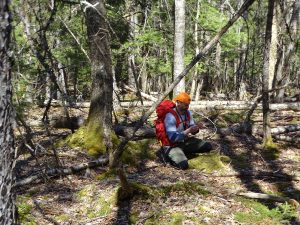 Root collars of trees and rotting logs support very diverse epiphyte communities, especially in hardwoods.
Root collars of trees and rotting logs support very diverse epiphyte communities, especially in hardwoods.
Listen to an audio of Sean talking about the importance of rotting logs in forests: “…not only do you get species growing on them that don’t grow elsewhere in the forests, but the richness of those microhabitats exceed everything else.”

Left: Base of Yellow Birch. Right Rotting log, not very old, already covered with bryophytes. Fern is a Christmas Fern. Photos on Apr 27, 2024

Left Stairstep Moss on exposed roots of Yellow Birch. Right: Bazzania trilobata (a liverwort) on old wood, likely softwood, on forest floor.
– Hylocomium splendens (Stairstep Moss). View description on Wikipedia.
On distingusihing it from other species, see bryomonitoring.ca page. NatureServe Conservation Status: S5 (Secure in NS)
– Bazzania trilobata (Greater Whipwort or Threelobed Bazzania), a liverwort.
Pics at Maryland Biodiverity Project; description: “Bazzania trilobata is one of the largest leafy liverworts. Note its three teeth at the end of each apex of the leaves.” Habitat: On deacying logs, earth and stone, banks etc., in woods. Not recorded from limestone regions. The species exhibits a wide series of variations in size, color and in habit, due mostly, perhaps to differences in the habitats…The most luxuriant form of the species grows erect in large tufts in very moist, shaded places.” (From The Genus Bazzania in the United States and Canada by M Fulford in American Naturalist, 1936.) NatureServe Conservation Status: S5 (Secure in NS)
STOP 5: Tree Skirt Moss on Sugar Maple
 Pseudanomodon attenuatus
Pseudanomodon attenuatus
Sean says it was just starting to come in; he sees it commonly on sugar maple.
Pics on Consortium of Bryophyte Herbaria. From Flora of Pennsylvania: “Plants grow close together forming dull looking green mats. Individual leaves are triangular with a rounded base and a slightly rounded tip. Likes to grow on tree trunk bases, and dry calcarious rocks. Also on soil banks.” NatureServe Conservation Status: S5 (Secure in NS).
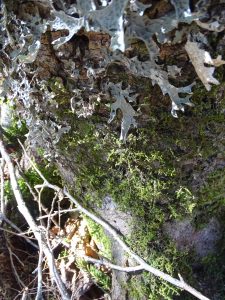
Neckera pinnata on Beech. Lungwort Lichen above. Sean said there more Porella platyphylla (Scalewort) (See Stop 2 above) at its base.
STOP 6 Neckera pinnata on Beech
Recognized as an Old Growth forest species. “In the northern hardwoods of North America it mainly grows on the bark of maples and is considered a good indicator of old-growth forests (Frahm, 1992).” – cited in The importance of large-tree retention for the persistence of old-growth epiphytic bryophyte Neckera pennata in selection harvest systems, Edman et al., 2016 in Forest Ecology & Management. They found in studies in N.B. that “Selection cutting strongly influence the old-growth bryophyte Neckera pennata [and that] the decrease in N. pennata results from reduction in large maples and crown cover.”
Pics in Consortium of Bryophyte Herbaria.
From description on www.botanikks.com: “The feathered shag-moss has a distinctive appearance, characterized by its long and narrow fronds. The fronds of this moss are intricately divided and resemble the feathers of a bird. The plant is generally green in color, with a glossy surface. The fronds grow to a height of 2-5 cm, with a width of 0.5-1.5 cm. The stem of the plant is thin and wiry, with a reddish-brown color.” – NatureServe Conservation Status: S5, (Secure in NS).
What are Bryophytes, Mosses, Liverworts, Lichens?
Bryophytes [From Wikipedia] (/ˈbraɪˌoʊfaɪts/) are a group of land plants, sometimes treated as a taxonomic division, that contains three groups of non-vascular land plants (embryophytes): the liverworts, hornworts, and mosses. In the strict sense, Bryophyta consists of the mosses only. Bryophytes are characteristically limited in size and prefer moist habitats although they can survive in drier environments. The bryophytes consist of about 20,000 plant species. Bryophytes produce enclosed reproductive structures (gametangia and sporangia), but they do not produce flowers or seeds. They reproduce sexually by spores and asexually by fragmentation or the production of gemmae. Though bryophytes were considered a paraphyletic group in recent years, almost all of the most recent phylogenetic evidence supports the monophyly of this group, as originally classified by Wilhelm Schimper in 1879.The term bryophyte comes from Ancient Greek βρύον (brúon) ‘tree moss, liverwort’, and φυτόν (phutón) ‘plant’. View also “What are Bryophytes” (section of Southern Illinois University Carbondale website, archived on the Web Archive). [See Liverworts and hornworts by Maggy Wassilieff for a brief description of differences between mosses, liverworts and hornworts.]
View YouTube Video: Bryophyte Course Part 1
“Part 1 of our 2023 Cofnod course on Bryophytes by Lucia Ruffino. Lucia introduces us to the different types of Bryophyte: Moss, Liverwort and Hornwort. Oct 3, 2023
Confod Online Species ID Courses (Cofnod is the North Wales Local Environmental Records Centre).”
Lichens: [from U.S. Forest Service]Lichens are a complex life form that is a symbiotic partnership of two separate organisms, a fungus and an alga. The dominant partner is the fungus, which gives the lichen the majority of its characteristics, from its thallus shape to its fruiting bodies. The alga can be either a green alga or a blue-green alga, otherwise known as cyanobacteria. Many lichens will have both types of algae.
Cyanolichen: Lichens in which one of the symbionts is a cyanobacteria (also referred to as “blue-green algae). Cyanobacteria can capture atmospheric nitrogen gas (N2) and convert it into forms such as ammonium (NH4+) usable by plants, so adding a valuable nutrient to the forest ecosystem.
Some Introductory Guides
Lichens
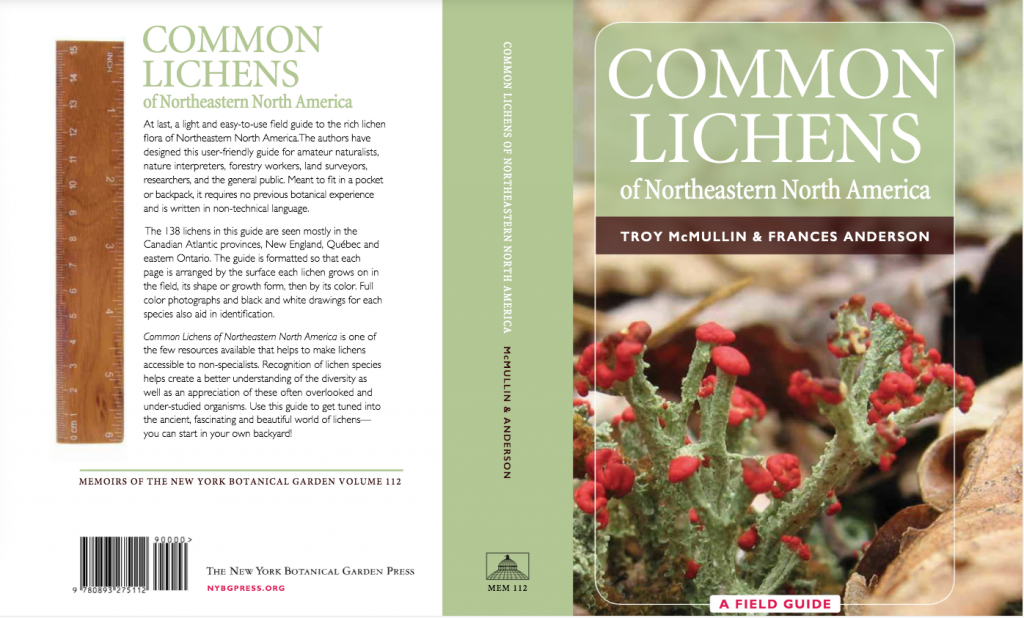
Common Lichens of Northeastern North America by Troy McMullin and Francis Anderson, 2014. Click on image above to read the description. “At last, a light and easy-to-use field guide to the rich lichen flora of Northeastern North America… Meant to fit in a pocket or backpack, it requires no previous botanical experience and is written in non-technical language.”

Mosses, Liverworts, and Hornworts A Field Guide to the Common Bryophytes of the Northeast by Ralph H. Pope 2016. Comstock Publishing (Cornell University).
“This photo-based field guide to the more common or distinctive bryophytes of northeastern North America gives beginners the tools they need to identify most specimens without using a compound microscope. Ralph Pope’s inviting text and helpful photographs cover not only the “true” mosses but also the Sphagnaceae (the peat mosses), liverworts, and hornworts.”

